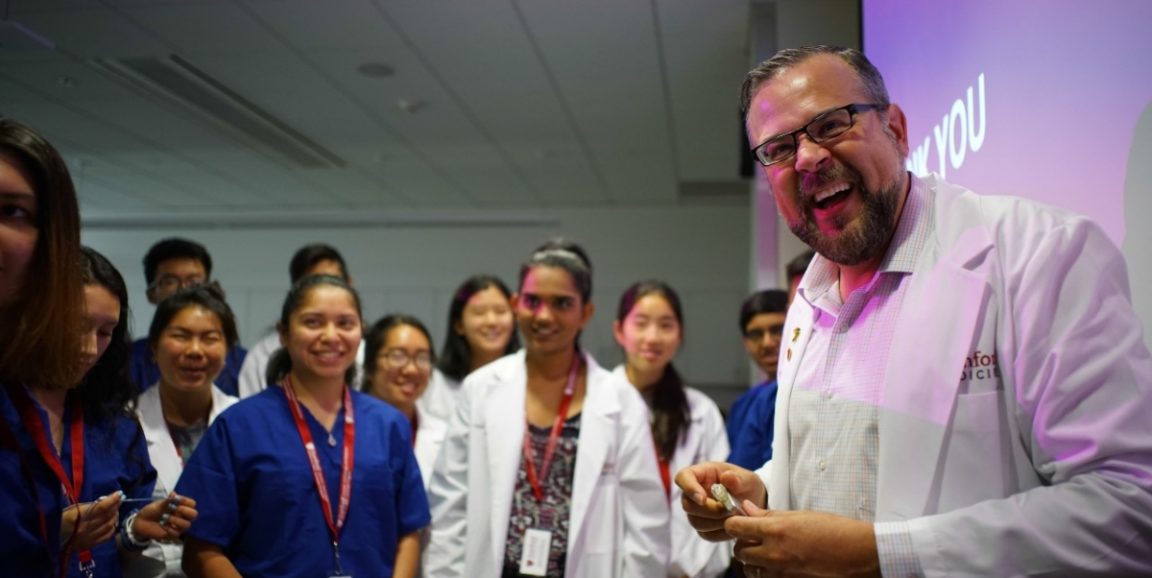The soft beeping sound that filled the quiet classroom had an unusual quality to it. The 24 high school and pre-med students enrolled in Stanford's Science, Technology and Medicine Summer Program listened intently. The beeping was coming from inside their instructor's chest.
Hugo Campos, a Stanford Medicine X ePatient and White House Champion of Change for Precision Medicine, was sharing an important lesson -- how to "turn off" a defibrillator (in case of surgery or device malfunctioning). He demonstrated this using a small handheld magnet to flip the tiny reed switch inside the defibrillator entwined with his own heart. Once he removed the magnet, his defibrillator turned on again and the beeping stopped.
The students had just practiced one of the most important skills the course is designed to emphasize: the ability to listen attentively to patients.
"We developed this two-week summer course last year because we wanted to create compassionate individuals in health care," Larry Chu, MD, executive director of Stanford Medicine X, told me. "What's great about this program is they are learning from patients, and they are learning early on that patients have expertise to offer."
Recently, Campos, who is shown on the right in the photo above, shared his experience and expertise with the students.
"When I was 37 I ran up stairs to catch the BART and I passed out on the platform," Campos said. "Three years later I was diagnosed with hypertrophic cardiomyopathy," a common genetic heart condition that can cause heart arrhythmias, congestive heart failure and sudden death.
To prevent cardiac arrest, Campos received an implantable cardioverter defibrillator -- a surgically implanted device attached to wires threaded through the veins and into the heart. Unfortunately, because of his genetic heart condition and this device, Campos was twice denied health insurance before 2014, when he was able to buy insurance in the Covered California insurance exchange.
"I had a device in me and no idea if it was working," Campos recalled thinking.
He needed to know if the device he trusted with his life was functioning, so he went online, bought a pacemaker programmer and enrolled in a course in South Carolina to learn how to use it.
"I wasn't proud of this," Campos said. "It's not good that I needed to go to these lengths. But I just had to."
The ordeal made Campos realize how important it is for patients to have easy access to their own health data.
"My Fitbit tells me when my battery is low, my doorbell tells me when someone walks by, and yet from a 30K defibrillator that lives inside my body... crickets, I get nothing. Would it make any sense to have a car where the dashboard of the car isn't in front of you, it's in front of the mechanic? ... I should have a portal so I can see what's going on with the device that's in my body."
A student asked if he could feel when the defibrillator worked.
"Yes," Campos said. "It's not pleasant." The defibrillator gives a burst of eight ATP (anti-tachycardia pacing) pulses that can gently correct a heart rhythm, or an electric shock.
"What's really scary," Campos said, "is going through the experience of having your heart malfunction. It's a bit like jumping out of a plane and the parachute doesn't work, and then when the device is ready to deliver ATP it's like the parachute opens. It's a welcome relief."
'It feels, in a way, really empowering to talk about this," Campos said.
He taught the students about pacemakers (they prevent the heart from dropping below a set rate) and defibrillators (which can prevent the heart from going too slow as well, but are mainly used to stop a fast, abnormal heart rhythm) saying, "even people who have these devices sometimes don't understand the difference," or how they work.
Defibrillators actually stop the heart, he explained. "In movies you see a person getting a defib shock and it looks like they are starting the heart. No. It stops the heart in hopes that the heart restarts on its own in normal sinus rhythm."
He also taught the students to listen.
"When they become clinicians, they are going to think back to this and they are going to listen," Chu whispered to me during class. "They will never not know what it's like to listen to the patient."
Photo courtesy of Stanford Medicine X




